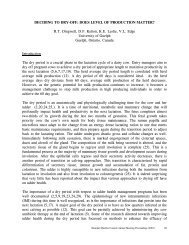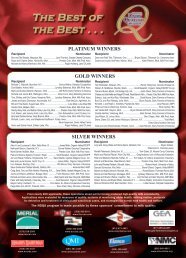Milking System Cleaning and Sanitizing - National Mastitis Council
Milking System Cleaning and Sanitizing - National Mastitis Council
Milking System Cleaning and Sanitizing - National Mastitis Council
You also want an ePaper? Increase the reach of your titles
YUMPU automatically turns print PDFs into web optimized ePapers that Google loves.
system shall be sanitized. This is done to eliminate bacteria that may grow on equipment surfaces<br />
between milkings even when well cleaned <strong>and</strong> acid rinsed. Flushing an EPA registered sanitizer<br />
through the system, so that all milk contact surfaces are contacted, minimizes bacteria counts at<br />
start up. Sanitizers are allowed to be used without a follow-up water rinse. Typically chlorine or<br />
iodine sanitizers are used.<br />
Alternatives to acid rinse products are acid sanitizers. These are based on organic acids that provide<br />
acid for removing mineral deposits <strong>and</strong> they are also classified by EPA as sanitizing agents. They<br />
allow both steps to be accomplished in one operation.<br />
The main task is effectively cleaning <strong>and</strong> sanitizing milking equipment at appropriate intervals so<br />
that raw milk bacteria counts are acceptable <strong>and</strong> meet whatever bonus st<strong>and</strong>ards may be in place.<br />
<strong>Cleaning</strong> programs must also be cost effective, non-damaging to system components <strong>and</strong> nonthreatening<br />
to the environment within the framework of current <strong>and</strong>/or future regulations.<br />
Future Farms<br />
More dairy farms in the future will milk hundreds or thous<strong>and</strong>s of cows daily so it will be critical<br />
that the cleaning systems are capable of cleaning these large facilities in the short intervals available<br />
between milkings. On some dairy farms robotic milking systems will be in use in the future. Even<br />
though they will milk cows automatically they will also have to be cleaned thoroughly <strong>and</strong><br />
automatically after each cow has been milked. This will pose challenges because of the<br />
unpredictable pattern of use by the cows.<br />
Trouble Shooting <strong>Cleaning</strong> Problems<br />
<strong>Cleaning</strong> problems may occur on any farm. The end result often is an elevated bacteria count.<br />
Some of the problems are relatively easy to locate <strong>and</strong> remedy while others require more effort.<br />
Did the water heater quit or partially fail? Is the water flow rate into the sink or cleaning vat<br />
adequate to minimize filling time <strong>and</strong> reduce heat loss? Sufficient hot water is critical for system<br />
cleaning <strong>and</strong> without it problems will arise. Checking the hot water supply for adequate<br />
temperature <strong>and</strong> volume is usually an early step in trouble shooting. Checking it with an accurately<br />
calibrated thermometer is the simplest way to determine the actual cleaning solution temperature.<br />
Water hardness can vary a good deal <strong>and</strong> can limit cleaner effectiveness. Water hardness chemicals<br />
can link with cleaning chemicals <strong>and</strong> reduce their effectiveness. A water hardness evaluation is<br />
always a necessary first step in determining the proper cleaner to use <strong>and</strong> in what concentrations.<br />
The main water hardness chemicals are salts of calcium <strong>and</strong> magnesium. They can accumulate in<br />
water heating equipment <strong>and</strong> reduce the capacity to below adequate. Buildups in water pipes can<br />
restrict the flow of hot water to cleaning tanks or sinks. High levels of these minerals may leave<br />
dull gray films on cleaned surfaces. They are removed by treating with acid products.<br />
Water borne minerals can combine with milk components to form a buildup of material called<br />
milkstone. This can build up in successive layers <strong>and</strong> form a tough deposit that provides a good<br />
location for bacteria to grow <strong>and</strong> possibly cause problems. Milkstone can be removed by repeated<br />
cleaning with alternating caustic <strong>and</strong> acid solutions.<br />
58 <strong>National</strong> <strong>Mastitis</strong> <strong>Council</strong> Regional Meeting Proceedings (2002)





